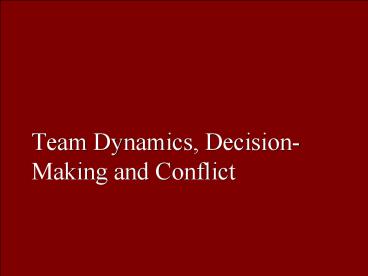Team Dynamics, DecisionMaking and Conflict - PowerPoint PPT Presentation
1 / 19
Title:
Team Dynamics, DecisionMaking and Conflict
Description:
better when tasks are clear, easy to implement. task interdependence ... arrogant communication heightens conflict perception. Lack of motivation ... – PowerPoint PPT presentation
Number of Views:627
Avg rating:3.0/5.0
Title: Team Dynamics, DecisionMaking and Conflict
1
Team Dynamics, Decision-Making and Conflict
2
Team-Based Organization
Management Team
Team A
Team B
Manager
Employee
3
Team Effectiveness Model
4
Team Design Elements
- Task characteristics
- better when tasks are clear, easy to implement
- task interdependence
- share common inputs, work processes, or outcomes
- Team size
- smaller teams are better
- but large enough to accomplish task
- Team composition
- motivation and competencies to perform task in a
team environment - team diversity
5
Stages of Team Development
Forming
6
The Trouble With Teams
- Individuals better/faster on some tasks
- Process losses - cost of developing and
maintaining teams - Companies dont support best work environment for
team dynamics - Social loafing
- Group think
- Role disfunction
7
Organizational conditions imposed upon group
- Organizational Culture, structure and strategy
- Organizational resources
- Performance evaluation and reward system
- Physical work setting
8
Conditions for Social Loafing
- Low task interdependence
- Individual output not visible
- Routine, uninteresting tasks
- Low task significance
- Low collectivist values
9
Groupthink
- The tendency of highly cohesive groups to value
consensus at the price of decision quality by
avoiding conflict and withholding of dissenting
opinions
10
Conditions for Groupthink
- Culturally defined
- Team is highly cohesive
- Team is isolated from outsiders
- Team faces external threat
- Team has recent decision failures
- Team leader tries to influence decision
- Organization does not respond well to mistakes
11
Group roles
- Task roles (initiator, information and opinion
seeker, clarifier, co-ordinator, critic) - Maintenance roles (encourager, harmoniser,
tension reliever, feeling expresser, follower) - Dysfunctional roles (Blocker, agressor, deserter,
dominator, recognition seeker, cynic) - Important
- Roles need to be balanced according to outcome
rather than individual needs or preferences
12
Group Polarization Process
High Risk
Social Support Persuasion Shifting Responsibility
Low Risk
13
Decision Making Model
1. Identify problem
2. Choose decision style
6. Evaluate decision
3. Develop alternatives
5. Implement solution
4. Choose best solution
14
Problems with Problem Identification
- Perceptual Biases
- Perceptual defense
- Mental models
- Poor Diagnostic Skills
- Lack of time
- Complex situation
- Problems defined by solutions
15
Problems with Choosing Solutions
- Problems with Goals
- Ambiguous, subjective, conflicting
- Biased by personal goals
- Problems with Information Processing
- Limited info processing capacity
- Sequential evaluation with implicit favourite
- Problems with Maximizing
- Satisficing, not maximizing
16
Sources of Conflict
Goal Incompatibility
Differentiation
Task Interdependence
Lack of opportunity --reliance on
stereotypes Lack of ability -- arrogant
communication heightens conflict perception Lack
of motivation -- conflict causes lower
motivation to communicate, increases stereotyping
Scarce Resources
- Increases competition for resources to fulfill
goals
Ambiguity
- Lack of rules guiding relations
- Encourages political tactics
Communication Problems
17
Conflict and contradiction in organisations
- Conditions for conflict
- Decision-making assumes rationality
- Organisations are political
- Marxist theories of organisational conflict
- The de-skilling hypothesis
- Stratification theory
- Organisational diversity
18
Conflict Management Styles
High
Competing
Collaborating
Assertiveness
Compromising
Avoiding
Accommodating
High
Low
Cooperativeness
19
Structural Conflict Management
- Emphasize Superordinate Goals
- Reduce Differentiation
- Improve Communication/Understanding
- Reduce Task Interdependence
- Increase Resources
- Clarify Rules and Procedures































